Sphinginae subfamily
Sphingini tribe:
 |
Pink-spotted hawkmoth -- (Agrius cingulata) WO
stray
This moth is a very strong flier, but would only make its way to
Cayuga as a rare stray. There are not too many records from
New York state, but records exist for NJ and CT.
|
 |
Ceratomia amyntor
WO,
the Elm Sphinx or Four-horned Sphinx
The upperside of the forewing is brown with dark brown and white markings including a white costal area near the wing base,
dark streaks along the veins, and a white spot in the cell.
Larvae feed on Elm (Ulmus), birch (Betula), basswood (Tilia), and
cherry (Prunus). |
 |
The upperside of the forewing is pale brownish gray with wavy black
and white lines and a black-outlined white cell spot. The upperside
of the hindwing is gray with diffuse darker bands. |
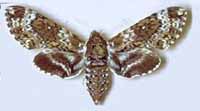 |
The upperside of the forewing is dark brown with a dusting of white
scales. Some moths have patches
of reddish or yellowish brown on the wings.
|
 |
The upperside of the forewing is gray with heavy black bands. The
upperside of the hindwing is brownish gray with no markings.
|
 |
This species is not recorded in Cayuga, and it has been seen just to the south
in nearby counties.
I suspect if you grow tomatoes, you are likely to encounter it.
|
 |
This species is not recorded in Cayuga.
If you grow tomatoes, however, you may have encountered it.
Larvae get very large and can strip a tomato plant.
|
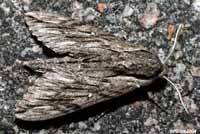 | The upperside of the forewing is gray with indistinct black and
white markings. There is a series of black dashes
from the base to the tip, and a small white cell spot. Might be present!
|
 |
Sphinx chersis WO, the Northern Ash Sphinx or Great Ash Sphinx
This species is probably present but may not
be common. Larval hosts are ash, lilac, privet, cherry, and quaking aspen.
|
 |
This species is not officially reported in Cayuga. We have them
on P.E.I., but I do not see them nearly as frequently
as I see the other Sphingidae. Probable! |
 |
The upperside of the forewing is gray-brown with wavy lines, black
dashes, and one or two small
white spots near the center of the costa. |
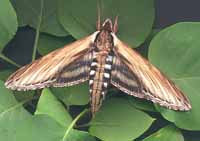 |
This species is reported just to the south in Tompkins and to the northeast.
I have taken them on P.E.I., Canada, and reared them on
lilac.
At rest the hindwings are usually completely covered.
|
 |
Sphinx luscitiosa
WO,
the Canadian Sphinx or
Clemen's Sphinx
The upperside of the forewing is yellowish gray in males and pale
gray with a faint yellow tint in females. In both sexes, the dark
border on the outer margin widens as it approaches the inner margin.
|
 |
If you have blueberries in the woods, then you might have the Poecila Sphinx.
They are pretty common here on Prince Edward Island, but don't fly
too far south of Massachusetts, being replaced by
Sphinx gordius in Connecticut. Probable. |
Smerinthini Tribe:
 |
The adults are also highly variable; sometimes wings of an individual
may be all one color or may have several colors, ranging from pale to
dark brown, and may have a white or pink tinge.
See the file for the female; she is different. |
 |
Pachysphinx modesta
RL,
the Modest Sphinx or Poplar Sphinx
This moth is recorded in Cayuga County by Randy Lyttle. It is fond of
poplars and willows.
They are common on Prince Edward Island. |
Pachysphinx modesta female, May 28, 2006, Randy Lyttle
 |
Named for the dull grey-blue spot (minus dark pupil) in the hindwing,
this moth has a wide distribution and is probably common in Cayuga
County.
I regularly see them on Prince Edward Island, and they are reported
as far south as Florida. |
 |
Named for the small eye-spot in the hindwing, this moth has a wide
distribution and is probably common in Cayuga County.
I regularly see them on Prince Edward Island, and they are reported
as far south as Florida.
|
 |
At my home in Montague, P.E.I., Canada, they are quite common.
I expect they are also present in Cayuga County. |
 |
This moth is widely distributed and fairly common.
Along the East Coast, it flies from P.E.I. to Florida. |
Macroglossinae subfamily
Dilophonotini tribe:
See Hemaris comparison to help distinguish
the next three species.
 |
Hemaris thysbe
RL, the Hummingbird Clearwing
This interesting day flier is reported in Cayuga by Randy Lytle, and
is widely reported to the north, east, south and west.
They are widely distributed in the east from P.E.I. to Florida. |
Hemaris thysbe, May, 2006, Randy Lyttle
 |
Hemaris diffinis WO, the
Snowberry Clearwing or Bumblebee Moth
Adults mimic bumblebees and are quite variable, both geographically
and seasonally. The wings are basically clear, with dark brown
to brownish-orange veins, bases and edges.
|
 |
Hemaris gracilis WO, the
Slender Clearwing or Graceful Clearwing
The wings are transparent with reddish brown borders. The outer edge
of the forewing transparent area is even and the forewing cell has a
median row of scales.
Questionable.
|
Philampelini tribe:
 |
This moth is reported for Tompkins justto the south, and it is fairly
often reported
along the coast from southern New Jersey
to central Maine.
Note the differences between this moth and the Pandorus Sphinx. |
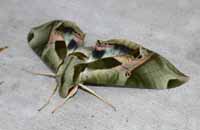 |
If you have Grape or Virginia Creeper nearby, then you probably have
this species.
I often get asked to identify larvae from areas not
previously reported. |
Macroglossini tribe:
 |
This day flier is widely distributed. If you have Virginia Creeper, you
probably have the Nessus Sphinx. Two bright, distinct, narrow yellow
bands are often visible on the abdomen.
|
 |
They are common in New Jersey and common
here on Prince Edward Island.
You will often see this species listed as Darapsa pholus,
especially in older literature.
It is not confirmed, however,
for Cayuga.
|
 |
Darapsa myron
WO, the Virginia Creeper Sphinx or the Grapevine Sphinx
This moth is not recorded on the U.S.G.S. site for Cayuga County
It is widely reported as far north as southern Maine. If you have the
foodplants indicated in the common names, you probably have this
species nearby. |
 |
If you have hydrangea growing near a stream, then you may have the
Hydrangea Sphinx.
It has not been reported in Cayuga, but
likely is presnt but uncommon.
|
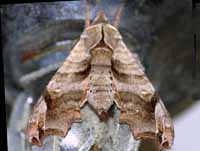 |
The moth's outer margin of the forewing is deeply scalloped.
The upperside is light brown with dark brown markings.
There is a small black and white spot near the tip. Small, early spring flier.
|
 |
Hyles gallii WO, the Bedstraw Hawk Moth
or Gallium Sphinx
This species is reported in Tompkins just to the south. I suspect it would be rare.
Some years I see them on P.E.I., some years, I do not.
|
 |
Hyles lineata
WO, the White-lined Sphinx
This species is not reported from Cayuga County. It flies across
southern New York and has strong migrating tendancies.
There are records from New Hampshire and Maine. |
 |
This moth is very much under reported across the United States. It
is a rapid day flier so is probably not in too many collections.
Grape is a popular larval host. It is confirmed for Cayuga by
Randy Lyttle.
|
Sphecodina abbottii, late May, 2006, Randy Lyttle
|
|
